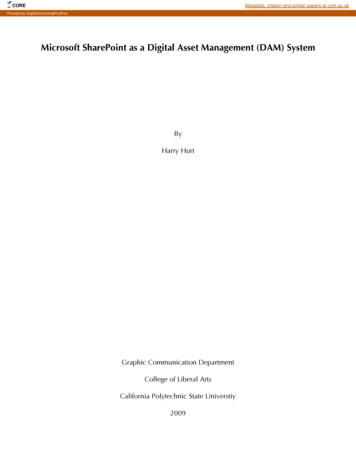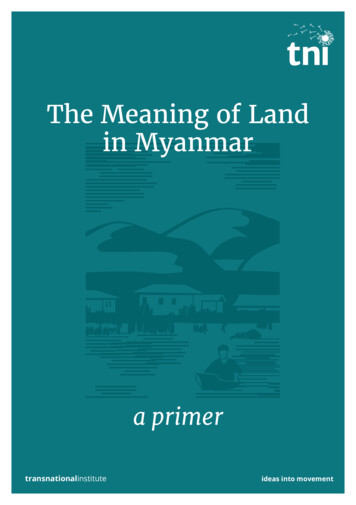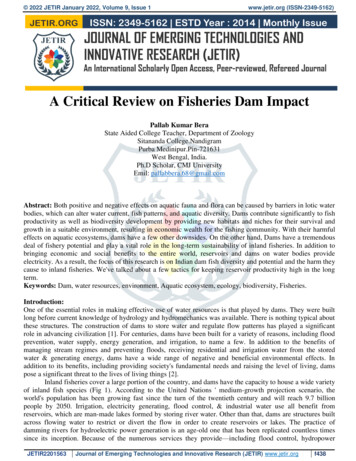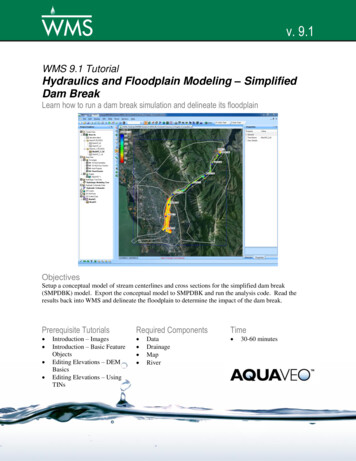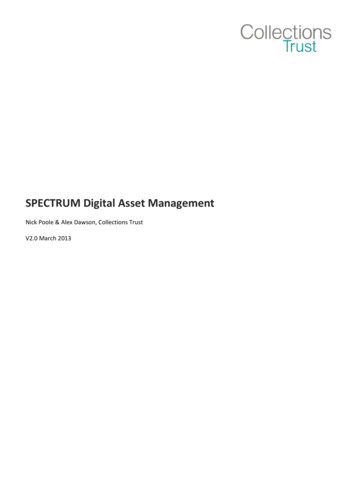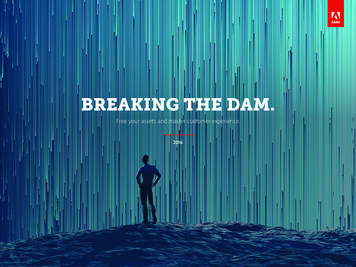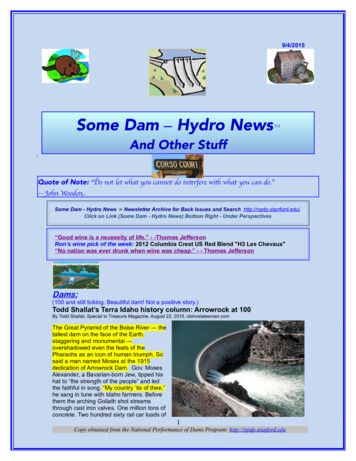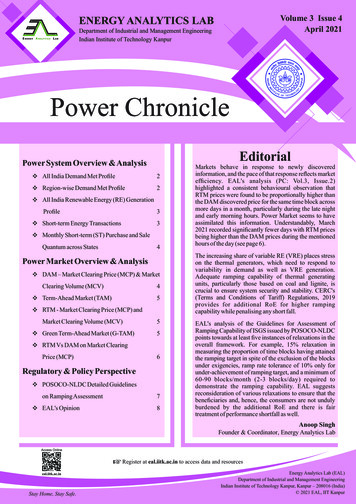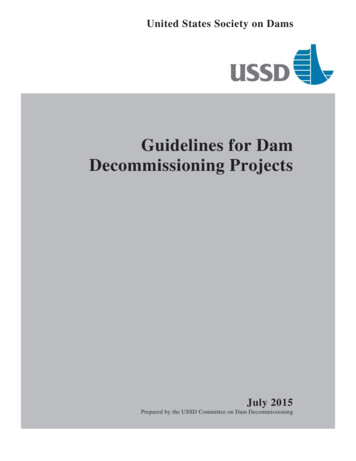
Transcription
ICOLD CODS New bulletin DraftDam Safety Management:Pre operational Phases of theDam Life CycleCommittee on Dam SafetyInternational Commission on Large Dams (ICOLD)
ICOLD CODS New bulletin DraftThis page left intentionally blank
ICOLD Committee on Dam SafetyChairman:CanadaP.A. razilBulgariaCanadaChileChinaCzech erbiaSlovakiaSloveniaSouth AfricaSpainSri LankaSwedenSwitzerlandTurkeyUnited KingdomUnited StatesiA. JovaniF. GiulianiS. McGrathE. NetzerF. de Gennaro Castro / C. H. de A.C. MedeirosD. ToshevD. N. D. HartfordC. PriscuZ. XuJ. PoláčekE. IsomakiM. PoupartU. Sieber / R. PohlM. Ghaemian / A. SoroushC. RicciardiK. Kido / H. KotsuboS. Dong‐HoonS. Dislere / D. KreismaneJ. P. F. M. JanssenG. Holm MidttØmmeA. Salim SheikA. Da Silva Gomes / L. CaldeiraA. AbdulamitE. N. BellendirI. TucovicP. PanenkaN. HumarI. SegersJ. C. De CeaB. KamaladasaM. BartschM. BalissatT. DinçergökA. HughesC. G. Tjoumas
Table of ContentsICOLD Committee on Dam Safety . iTable of Contents . iiList of Figures . vList of Tables . vForeword . 1Acknowledgments . 2Chapter 1 1.1.1.2.1.3.1.4.Why this bulletin? . 3Importance of dam safety at all development stages. 3Overarching Principles. 5Bulletin Structure . 6Chapter 2 2.1.2.2.Introduction. 3Dam development phases and Actors . 7Dam as a prototype . 7Related development phases . al activities at each of the pre‐operational phases . 9Definition and role of the different actors . 2.4.9.2.4.10.iiPreliminary studies . 7Feasibility Studies . 8Detailed design . 8Tendering Stage. 8Construction stage . 8Commissioning . 9The Investor / Owner . 10The Designer. 11Board of Consultants . 11Site supervisor . 11Contractor . 12Supplier . 13On Site Operator . 13Licensing agency . 13State or National regulatory agency. 13Public . 14
2.5.Involvement of the actors during a dam project development. 14Chapter 3 3.1.Key Issues to be addressed. 16Risks involved in design and construction of dams . 163.1.1. Non‐technical aspects . 163.1.2. Technical aspects – Major influence of uncertainties . 183.1.3. Need for monitoring . 203.2.Development stages and need for investigation . 213.2.1.3.2.2.3.2.3.3.2.4.3.2.5.3.3.Rehabilitation works and performance enhancements . 263.3.1.3.3.2.3.3.3.3.3.43.4.3.5.Introduction. 27Planning rehabilitation works . 30Performing rehabilitation works . 31Dam safety management during rehabilitation works. 31Dam scheme development as a continuous process . 35Risk management. 36Chapter 4 4.1.Dam Design . 22Construction phase . 23Construction supervision. 24First impounding / Commissioning. 25Operational documentation . 25Overarching Safety Management System . 38Concept of overarching management system . 384.1.1. Background. 384.1.2. Management context . 384.2.4.3.4.4.4.5.Form of management system activities . 40Delivering dam safety objectives through an integrated management system. 43Transformation of project objectives into implementable actions . 43Role of the Owner/Investor in securing the safety objectives . 474.5.1.4.5.2.4.5.3.4.5.4.4.5.5.4.6.Overall objectives . 47General responsibility of the Owner . 47Responsibility and tasks during design phase . 48Responsibility and tasks during construction and commissioning phases . 49Project performance vs. dam safety in the development of dam schemes . 49Owner Management System . 514.6.1. Policies and general organization. 514.6.2. Role of Monitoring and Evaluation . 514.6.3. Role of Audit, Review and Reporting . 524.7.Role of the other main actors in securing the safety objectives . 524.7.1. Role of the Designer . 524.7.2. Role of the Contractor . 534.8. Management of risk and uncertainty in a dam development . 534.9. Importance of Management of Changes . 554.10. Role of Arbitration in Disputes . 56iii
Chapter 5 5.1.Engineering principles . 57General consideration . 575.1.1.5.1.2.5.1.3.5.1.4.5.2.Safety Design Principles . 615.2.1.5.2.2.5.2.3.5.2.4.5.2.5.5.3.Design process. 57Safety engineering principles . 58Fundamental “Defence in depth” principles . 59Key capability requirements. 61Siting and Layout . 61Proven engineering practices . 62Safe materials and methods . 63Preserving asset function through life time . 63Specific principles for mechanical, electrical and control system equipment . 63Safety Assessment Principles. 645.3.1. General considerations of the required level of safety . 645.3.2. Safety Classification and Standard . 655.3.3. Performance assessment . 665.3.3.1. Structural performance .665.3.3.2. Hydraulic performance .675.3.4. Dam as a system . 675.3.5. Risk Analysis . 675.3.6. Safety assessment for serviceability (Delivery of Design Capability andPerformance Capacity) . 685.3.7. Considering human aspects during operation at the design stage . 68Chapter 6 -Conclusion. 70References. 71Glossary . 72Appendix A. 74Appendix B. 80iv
List of FiguresFigure 1.1 Extent of this bulletin . 4Figure 3.1 Uncertainty on dam environment and design factors susceptible of influencing the riskof dam failure . 23Figure 3.2 Safety Analysis Framework (from ICOLD Bulletin 154) . 28Figure 3.3 Impact of reservoir level lowering on rehabilitation works . 29Figure 4.1 General Form of a Management System (from ICOLD Bulletin 154). 39Figure 4.2 Integrated Management System (system of systems) to Achieve Dam Safety . 41Figure 4.3 Management System Arrangements to Achieve Dam Safety in Implementation . 42Figure 4.4 Key Capability Requirements and Capability Requirements . 44Figure 4.5 Extreme Event Characteristics of Capability Requirements . 45Figure 4.6 Operational Characteristics of the Capability Requirements for Operation . 46Figure 4.7 Operational Characteristics of Constraints on a Dam Development . 46List of TablesTable 2‐1 Typical activities for different phases. 10Table 2‐2 Pre‐Operation Phases of a Dam Development . 15Table 3‐1 Typical risks encountered during design and construction of dams . 19Table 5‐1 Levels of defence in depth (adapted from INSAG 12) . 60v
This page left intentionally blankvi
ForewordIn 2011 the ICOLD Committee on Dam Safety (CODS) submitted a report aimed at complete characterization ofprocesses supporting the identification, tracking and effective addressing of all potential and actual problemsthat can impact the safety of the existing dams. The report approved as ICOLD Bulletin 154 Dam SafetyManagement: Operational Phase of the Dam Life Cycle recognized that within the complete life cycle of a dam(concept ‐ feasibility ‐ design – construction – commissioning – operation – rehab/decommissioning), theoperational phase was the longest and required that the organization responsible for the dam had a process inplace that was fully capable of addressing all aspects of dam safety.In the early stages of Bulletin 154 development, Working Group preparing the document and the entire CODScame to the conclusion that the management of dam safety in the operational phase was possibly the mostchallenging, and, taking into account the sheer number of existing dams, was also the most urgently needed.However, CODS also recognized that another document addressing all aspects of development andimplementation of the modern safety management approach to other phases of the dam life cycle should beconsidered as a priority task for the CODS in the future.This document extends the general approach and concepts presented in Bulletin 154 to all phases of dam lifecycle preceding the operational phase. Its importance cannot be overstated if one recognizes that many risksassociated with the operation of existing dams have their origins in other phases preceding the actualoperation. Although there are numerous ICOLD Bulletins addressing mostly technical aspects of planning,design, construction and commissioning of dams, there is not a single Bulletin which covers the subject in acomprehensive manner. The current document is the first attempt to capture all relevant dam safety aspectsin all preoperational phases by systematically characterizing the actors involved, their roles, the activities andcomplex interactions present in different phases of the dam lifecycle.Committee on Dam Safety members hope that the ideas developed and presented in the document willprovide a better guidance and help in identifying and eliminating potential sources of dam safety issues,before they actually happen when the dam has been already built and is being operated.Przemyslaw A. ZielinskiChairman, Committee on Dam Safety1
AcknowledgmentsThe Committee on Dam Safety and the ICOLD Executive gratefully acknowledge the contribution of membersof the Committee’s Working Group and the support provided by their sponsoring organizations. The final textof the Bulletin is the result of the collective effort of the entire CODS which continued providing generalguidance and valuable input during the period of 2013 to 2018. The task of converting this guidance intoguidelines for managing dam risks rested with the Working Group. The Group not only acted as a forum forexchange of ideas but was also instrumental in reviewing comments from CODS members. A workshop washeld at the 2017 Annual Meeting in Prague, where the draft of the Bulletin was presented to a broaderaudience and initiated valuable comments and remarks from the participants.The task of writing the drafts and preparing the final text was carried out by:1.Mr. M. Balissat, Working Group Leader, Senior Consultant at Stucky Ltd., Switzerland ‐ financial and inkind assistance provided by Stucky Ltd;2.Dr. D.N.D. Hartford, Principal Engineering Scientist, BC Hydro, Canada – financial and in kindassistance provided by BC Hydro;3.Mr. M. Poupart, previously Dam Safety Advisor at Electricité de France, presently IndependentConsultant, France ;It needs to be stressed that the effort provided by the members of the Working Group was extensive and itswork was instrumental for completion of the task. Working Group members had a substantial knowledge andexperience of dam safety issues. This breadth of perspective on regulatory, organizational, managerial andengineering aspects of dam safety management can hopefully provide the readers of this Bulletin with thehelp in conceiving and implementing a modern comprehensive management system for designing, buildingand commissioning dams.Przemyslaw A. ZielinskiChairman, Committee on Dam Safety2
Chapter 1 - Introduction1.1.Why this bulletin?Dams are massive structures retaining large water bodies able to cause substantial or even catastrophic damagesdownstream of their location. As such they represent a potential hazard in case of uncontrolled release of waterdue to overtopping by flood or by submergence caused by a sliding earth mass in the reservoir. Obviouslystructural failure of the dam body or its foundation or malfunction of water releasing structures constitute alsopotential hazards. Although many risks associated with dams are linked to the operation of these structures someof them are imbedded in the phases preceding operation. They can be found at the preliminary planning of thedam scheme, during the detail design of the structures, as well as during the construction and commissioningphases. Identifying the risk factors and trying to minimize them are essential to structural safety and to (planned)operational safety. Dam safety has to be adequately managed from the onset of a project development until itsconstruction and commissioning. It shall be pursued during the whole operation of the scheme. This means thathow dam safety is to be pursued in the operational phase of the life‐cycle must be developed in the design phaseof the project.Until present no bulletin of ICOLD was directly addressing this situation. Bulletins (see list in Appendix B) are eitherpurely technical or describing risk evaluation methods from a theoretical point of view. The present Bulletinaddresses the pre‐operational phases of a dam project and links them to the guidance of the previously issuedBulletin 154 which presents recommendations for safety management during the operation of the dam (see Fig.1.1).In phases preceding operation of a dam scheme (going from preliminary studies to commissioning) attention hasto be given to the implementation of engineering and construction measures (best practice) excluding or, at least,minimizing the risk of failure of the dam. They encompass both structural (retention of water) and operation(conveyance of water) oriented safety measures. Several factors (human and technical) tend to affect the safetyaspects of a dam. Whereas technical aspects are relatively easy to identify in design, human factors covers a broadrange of interfering and less strictly defined aspects going from personality conflicts within a working team todeficient communication and organizational flaws. Therefore management of the steps leading to the realizationof a dam scheme and its operation should be aware of these possible drawbacks and should put all necessaryefforts into identifying and controlling them.1.2.Importance of dam safety at all development stagesA decision to invest in the development of a dam is a very significant matter that can be of national and eveninternational importance from multiple perspectives. The investment involved is generally so large that it isimperative that the development fulfil all of the intended objectives and other objectives as might be determinedafter construction, or as determined over the economic evaluation period of the dam and beyond (the whole life‐cycle). It can be taken as a premise that the investment must be secured at the outset in such a way that theprinciple that development of the dam results in a net positive contribution to society is realised. Dam Safetyconsiderations have a pivotal role in securing the investment over the whole life‐cycle of the dam.3
Figure 1.1 Extent of this bulletinIn the modern context, Dam Safety considerations which include all aspects of safety management over the wholelife‐cycle contribute to a great deal more to securing the investment than previously considered when dam safetypertained to structural safety (ICOLD B59, 1987):The safety of a dam manifests itself in being free of any conditions or developments thatcould lead to its deterioration or destruction. The margin which separates the actualconditions of a dam, or the conditions it is designed for, from those leading to its damage ordestruction is a measure of its safety. To be safe, therefore, a dam has to be supplied withappropriate reserves, taking into account all reasonably imaginable scenarios of normalutilization and exceptional hazard which it may have to withstand during its life.By way of illustration, how dam safety is considered in the design phase influences construction costs and safetyduring construction, and later on operational safety, costs, constructability and safety of modifications,improvements and renewal, and finally decommissioning.For instance, the choice of spillway type, a matter that is identified at the conceptual design or feasibility stage cansignificantly influence whole life‐cycle operational costs and the effectiveness of operational safety. Life‐cycleoperational costs that can be influenced at the conceptual design stage go far beyond the physical componentsand include surveillance and monitoring costs, staffing costs, maintenance and repair costs and ultimatelyrepair/upgrading/renewal costs prior to the end of the life‐cycle.In addition to the physical and operational justifications for including whole life‐cycle safety considerations at anearly stage of the design process, there are sound financial reasons for the dam Investor to consider earlyinvestment in dam safety for financial efficiency and for insurance reasons. The financial efficiency dimensionsrelate to the economics of the project over the whole life‐cycle from the perspectives of asset value, operationalcosts and refurbishment/renewal costs whereas the insurance dimensions relate to the overall protection of theinvestment. The investment in the dam is “at risk” from the initial stages of the investment up to the end of theeconomic evaluation stage with the investment most “at risk” initially from first filling to approximately 5‐yearsinto the service life, and again at the end of the service life of the dam. The relatively long pay‐back period for thecapital investment in a dam means that the total financing and operational costs of a dam will not become net‐positive until well into the economic evaluation life‐cycle. During this time, the effects of ageing will begin tomanifest themselves, and safety expectations can be expected to increase. A robust design that considers theseissues at the outset can significantly influence the repair and replacement costs at the later stages of the economic4
evaluation process. In straightforward terms, securing safety contributes to securing the investment and vice‐versa.1.3.Overarching PrinciplesICOLD Bulletin 154 defines nine overarching principles for dam safety that are sufficiently general to be applieddirectly or with minor alteration over all phases of the life‐cycle of a dam. These principles are as follows:a) Justification for dams: Dams should be constructed and operated only if they yield an overall benefit tosociety.b) Fundamental Dam Safety Objective: The fundamental dam safety objective is to protect people, propertyand the environment from harmful effects of misoperation or failure of dams and reservoirs.c) Responsibility for Operational Integrity and Safety: The prime responsibility for operational integrity andsafety of a dam should rest with the Dam Owner.d) Role of Government: The legal and governmental framework for all industrial activities, includingoperation of dams, provides the overarching structures for operational integrity and safety assurance.e) Leadership and management for Safety: Effective leadership and management for operational integrityand safety should be established and sustained over the life cycle of the dam.f) Balancing of Protection across Competing Objectives: Protection should seek to achieve a balance acrosscompeting objectives to provide the highest level of operational integrity and safety that can reasonablybe achieved.g) Limitation of Risk to Individuals and Society: Measures for controlling risks from dams should ensure thatno individual bears an unacceptable risk of harm, and that the risks to society do not exceed the risktolerance levels of society.h) Sustainability of Dams and Reservoirs: In order to secure the societal value, dams and reservoirs must besustained in the long term. To ensure sustainability of dams, all reasonably practicable efforts should bemade to prevent and mitigate failures and accidents.i) Emergency Preparedness and Response: Appropriate arrangements should be made for emergencypreparedness and response for dam failures and accidents.Clearly, one of the objectives of the pre‐operational phases is to ensure that the dam conforms to all of theseprinciples when it goes into service. Importantly, for most dam constructions, the dam enters in operation as soonas impoundment begins and often before the construction has been handed over to the Investor/Owner.Of the 9 overarching principles the following apply directly without any alteration to the pre‐operational phases: Justification for Dams Fundamental Safety Objective Balancing of Protection across Competing Objectives Limitation of Risk to Individuals and Society Sustainability of Dams and Reservoirs Emergency Preparedness and ResponseThe remaining three, Responsibility for Operational Integrity and Safety, Role of Government and Leadership andManagement for Safety, can be modified and made specific to the pre‐operational phases in a way that there canbe a smooth transition to the operational phase when the dam is handed over to the Investor/Owner.The Investor/Owner has the continued full responsibility to maintain leadership and management for safety duringall phases of a project (planning, design, construction, quality control) including transitioning to the operationphase, and subsequently through the operational phase and then into either renewal or decommissioning.The three revised Pre‐operational Safety Principles are provided as follows:5
Responsibility for Integrity and Safety in the Pre‐Operational Phases:The prime responsibility for the overall integrity and safety of a dam should rest with the Dam Owner. The Owneris responsible for the third party liabilities. Responsibility for meeting safety objectives of the design should restwith the Designer, but the Owner has to make sure that he is fully understanding and accepting the design of theproject. He further carries full responsibility for implementing an adequate quality control system during designand construction. Responsibility for safety of the works during construction and commissioning should rest withthe Construction Supervising Engineer as determined by the contractual arrangements established by theInvestor/Owner.Role of Government:The legal and governmental framework for all industrial activities, including licensing, development, operation, andalteration of dams, provides the overarching structures for pre‐operational and operational integrity and safetyassurance, and for safety during renewal or retirement from service. The Government through its regulatoryagency requires a number of policies and design criteria to be satisfied. But the Owner has to be even moreconservative for reducing potential risks to a level satisfactory for the protection of the public and its own assets.Leadership and Management for Safety in the Pre‐Op
implementation of the modern safety management approach to other phases of the dam life cycle should be considered as a priority task for the CODS in the future. This document extends the general approach and concepts presented in Bulletin 154 to all phases of dam life
